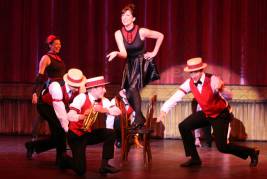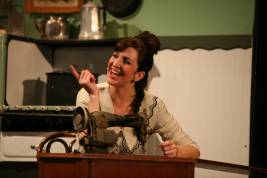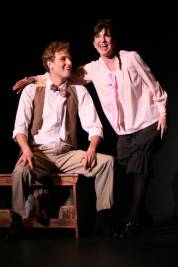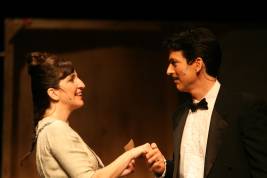
If the best reason to see Broadway’s Funny Girl in 1964 could be summed up in a name (Barbra Streisand, for those living under a rock), then the same can be said for its current revival at Downey Civic Light Opera. That name is Karen Volpe, the triple threat who first caught this reviewer’s attention as Ado Annie in DCLO’s Oklahoma! a few years back and now dazzles in the proverbial role of a lifetime.
 Funny Girl is, as any true musical theater aficionado will tell you, the story of Broadway and film star Fanny Brice, centering on the comedienne’s rise to stardom and on her rocky relationship with entrepreneur/gambler Nicky Arnstein.
Funny Girl is, as any true musical theater aficionado will tell you, the story of Broadway and film star Fanny Brice, centering on the comedienne’s rise to stardom and on her rocky relationship with entrepreneur/gambler Nicky Arnstein.
Despite admonitions from family and friends against a career in show business (“If a girl isn’t pretty like a Miss Atlantic City, all she gets in life is pity and a pat”), young Fanny truly believes that “I’m The Greatest Star,” and goes on to prove it in production numbers like “Cornet Man,” “His Love Makes Me Beautiful,” and “Rat-Tat-Tat-Tat,” ending up a headliner in the world famous Ziegfeld Follies. Accompanying her on her road to stardom is the tall, dark, and handsome Mr. Arnstein (“I Want To Be Seen With You Tonight”), who finds in Funny Fanny an attraction that simply cannot be denied (“You Are Woman, I Am Man”). Still, as any country singer will tell you, falling in love with a gambler is risky business, and though it doesn’t bode well for a happily-ever-after ending, it does give Funny Girl one of the greatest torch songs ever in a Broadway musical (“The Music That Makes Me Dance”).
With music by Jule Styne, lyrics by Bob Merrill, and book by Isobel Lennart, Funny Girl does end up spending too much time on its peripheral characters (the movie adaptation savvily cut “Who Taught Her Everything” and “Find Yourself A Man,” i.e. virtually every song not sung by Streisand), but when the focus is on Fanny, the musical hits one high note after another.
 Director Marsha Moode simply could not have made a better choice for Funny Girl’s title role than Volpe, whose performance pays tribute to Streisand’s all the while making the role of Fanny most definitely her own. Like her illustrious predecessor, Volpe’s comedic chops captivate from the get-go even as her unconventional beauty sneaks up on you little by little. She’s also likeable as all get-out (a must for any Fanny), sings with one hell of a belt, and demonstrates the kind of razor-sharp comedic timing that Fanny herself must have had in spades.
Director Marsha Moode simply could not have made a better choice for Funny Girl’s title role than Volpe, whose performance pays tribute to Streisand’s all the while making the role of Fanny most definitely her own. Like her illustrious predecessor, Volpe’s comedic chops captivate from the get-go even as her unconventional beauty sneaks up on you little by little. She’s also likeable as all get-out (a must for any Fanny), sings with one hell of a belt, and demonstrates the kind of razor-sharp comedic timing that Fanny herself must have had in spades.
Other roles pale next to Fanny’s, but that doesn’t mean they don’t offer their performers ample opportunities to shine. As Nick Arnstein, Downey CLO favorite Robert Standley combines leading man good looks and charm with some fine musical theater pipes—and has great romantic chemistry with Volpe to boot. Other fine performances are given by Sandra Tucker as Fanny’s mom Rosie, hoofer extraordinaire Peter Schueller as her best chum Eddie, John F. Briganti as Florenz Ziegfeld, Osa Danam as neighbor Mrs. Strakosh, and William Crisp as Tom Keeney.
Director Moode adds many signature touches to the production, with choreographer Denai Lovrien giving the huge cast plenty of fancy footwork to execute, particularly in Ziegfeld Follies production numbers. Musical director Jimmy Van conducts the Downey Civic Light Opera orchestra with flair.
Supporting roles in Funny Girl’s cast of thirty eight are filled by (among others) Michael McGreal (John, Ziegfeld Stage Manager), Kit Wilson singing gorgeously as Ziegfeld Tenor, Aleesha McNeff (Maude), Araceli Applegate (Polly), and Dee Wilson (Mrs. O’Malley). Also adding energy and pizzazz are Jessica Brusilow (Keeney Girl, Rose), Steven Chavarria (James, Pianist), Greg Hardash (Sammy), Espiridion Magana (Joe), Callie Prendiville (Keeney Girl, Rose), Derek Rubiano (Howard, Ziegfeld Director), Kyle Van Amburgh (Herbie), Frances Wulke (Ida, Ziegfeld’s Wardrobe), showgirls Rachael Meyers and Chelsea Vann, dancers Anne Arreguin, Israel Cortez, Nicole Davey, Marisa Martinez, Anne Schroeder, and Matthew Thurmond (Cornet Man), ensemble members Jacqueline Case, Kristian Espiritu, Randy Long, Karen Merrill, Eric A. Peterson, and Katherine Washington, and children Clair Bowen, Grace Bowen, and Devon Cornair.
 Lighting designer Jacqui Jones and sound designer Jay Lee do terrific work as does technical director Gary Richardson. Set designer Mark W. Keller uses mostly scrim backdrops on the Downey Theatre’s large center stage, but merits a big thumbs-up for the best and most detailed sidestage sets I can recall at the Downey Theatre, ideal for the intimacy of scenes taking place in Fanny’s dressing room, Rosie’s kitchen, or the restaurant where Nicky takes Fanny out on a date. Elizabeth Bowen’s costume designs are detailed and plentiful, despite exhibiting a rather haphazard attention to Funny Girl’s mostly 1910s timeframe. Sally Casey Bell is stage manager.
Lighting designer Jacqui Jones and sound designer Jay Lee do terrific work as does technical director Gary Richardson. Set designer Mark W. Keller uses mostly scrim backdrops on the Downey Theatre’s large center stage, but merits a big thumbs-up for the best and most detailed sidestage sets I can recall at the Downey Theatre, ideal for the intimacy of scenes taking place in Fanny’s dressing room, Rosie’s kitchen, or the restaurant where Nicky takes Fanny out on a date. Elizabeth Bowen’s costume designs are detailed and plentiful, despite exhibiting a rather haphazard attention to Funny Girl’s mostly 1910s timeframe. Sally Casey Bell is stage manager.
Anyone who has anything to do with Southern California musical theater owes it to him or herself to catch Karen Volpe in her tremendous star turn as Fanny Brice—and that goes for average everyday musical theater fans as well. The divine Miss V earns every single second of her standing ovation.
Downey Theatre, 8435 E. Firestone Blvd., Downey
www.downeyciviclightopera.org
–Steven Stanley
June 3, 2011



 Since 2007, Steven Stanley's StageSceneLA.com has spotlighted the best in Southern California theater via reviews, interviews, and its annual StageSceneLA Scenies.
Since 2007, Steven Stanley's StageSceneLA.com has spotlighted the best in Southern California theater via reviews, interviews, and its annual StageSceneLA Scenies.







 COPYRIGHT 2025 STEVEN STANLEY :: DESIGN BY
COPYRIGHT 2025 STEVEN STANLEY :: DESIGN BY